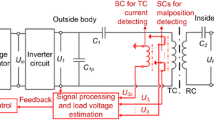Abstract
Purpose
Multiple surface electrodes must be attached to the skin for high-accuracy signal source position estimation inside the human body, and can be uncomfortable for the subject. This paper presents a method for signal source position estimation inside the human body to solve this problem. In our method, the human body is modeled as an electrical circuit, consisting of an internal resistance and a potential source, which can both be measured simultaneously via two surface electrodes using switching voltage divider technology. The purpose of this study is to reduce the number of electrodes required for human body signal source localization, and the estimation ability of the proposed method is confirmed here.
Methods
A single signal source consisting of positive and negative poles was set inside a water tank filled with tap water to simulate a human body, and a sine wave was generated using this signal source. Stainless steel measurement electrodes were used to obtain the signal source potential and internal resistance. Equations representing the signal source position were developed using the information at each electrode, and signal source position was estimated by solving simultaneous equations.
Results
Signal source position was estimated correctly with maximum localization error of 2.6 mm.
Conclusion
Our method showed that the signal source position inside a water tank filled with tap water can be estimated using internal resistance. This paper presents preliminary study results towards our final goal of the signal source position estimation inside a human heart using small numbers of electrodes.
Similar content being viewed by others
References
Noble A, Johnson R, Thomas A, Bass P. The cardiovascular system. 2nd ed. New York: Churchill Livingstone; 2010.
Bellman R, Collier C, Kagiwada H, Kalaba R, Selvester R. Estimation of heart parameters using skin potential measurements. Commun ACM. 1964; 7(11):666–8.
Vijayakumar R, Silva JN, Desouza KA, Abraham RL, Strom M, Sacher F, Van Hare GF, Haïssaguerre M, Roden DM, Rudy Y. Electrophysiologic substrate in congenital Long QT syndrome: noninvasive mapping with electrocardiographic imaging (ECGI). Circulation. 2014; 130(22):1936–43.
Ramanathan C, Ghanem RN, Jia P, Ryu K, Rudy Y. Noninvasive electrocardiographic imaging for cardiac electrophysiology and arrhythmia. Nat Med. 2004; 10(4):422–8.
Van Dam PM, Oostendorp TF, Linnenbank AC, van Oosterom A. Non-invasive imaging of cardiac activation and recovery. Ann Biomed Eng. 2009; 37(9):1739–56.
Lai D, Liu C, Eggen MD, Iaizzo PA, He B. Localization of endocardial ectopic activity by means of noninvasive endocardial surface current density reconstruction. Phys Med Biol. 2011; 56(13):4161–76.
Lai D, Sun J, Li Y, He B. Usefulness of ventricular endocardial electric reconstruction from body surface potential maps to noninvasively localize ventricular ectopic activity in patients. Phys Med Biol. 2013; 58(11):3897–909.
Lai D, Liu C, Eggen MD, Iaizzo PA, He B. Equivalent moving dipole localization of cardiac ectopic activity in a swine model during pacing. IEEE T Inf Technol Biomed. 2010; 14(6):1318–26.
Tysler M, Svehlikova J. Noninvasive finding of local repolarization changes in the heart using dipole models and simplified torso geometry. J Electrocardiol. 2013; 46(4):284–8.
Koiwa N, Masaoka Y, Kusumi T, Homma I. Sound localization difficulty affects early and late processing of auditory spatial information: Investigation using the dipole tracing method. Clin Neurophysiol. 2010; 121(9):1526–39.
Blenkmann A, Seifer G, Princich JP, Consalvo D, Kochen S, Muravchik C. Association between equivalent current dipole source localization and focal cortical dysplasia in epilepsy patients. Epilepsy Res. 2012; 98(2):3–223.
Sakaue Y, Okada S, Makikawa M. Electroencephalograph with switching voltage divider and its application to measurement of event-related potentials. Adv Biomed Eng. 2014; 3:94–100.
Yoshiwaki M, Murai A, Sakaue Y, Makikawa M. A new approach to estimate ECG signal source using voltage divider technology. Conf Proc SICE Annual Conf. 2014; 1:1460–5.
Murai A, Sakaue Y, Makikawa M. Evaluation of lower-leg swelling using electromyograms obtained with voltage-dividing electrodes. Ann Sports Med Res. 2014; 1(2):1007.
Smith ME, Halgren E, Sokolik M, Baudena P, Musolino A, Liegeois-Chauvel C, Chauvel P. The intracranial topography of the P3 event-related potential elicited during auditory oddball. Electroencephalogr Clin Neurophysiol. 1990; 76(3):235–48.
Volpe U, Mucci A, Bucci P, Merlotti E, Galderisi S, Maj M. The cortical generators of P3a and P3b: A LORETA study. Brain Res Bull. 2007; 73(4):6–220.
Higuchi M, Yazaki H, Kyoso M, Ishijima M. Property of a large sized body surface ECG electrode. Trans Jpn Soc Med Biol Eng. 2008; 46(5):483–8.
Matsuo T, Dendo I. Electrical properties of biomedical metal electrodes (DC properties of Metal electrode in physiological saline). Jpn J Med Electron Biol Eng. 1970; 8(2):151–9.
Author information
Authors and Affiliations
Corresponding author
Rights and permissions
About this article
Cite this article
Sakaue, Y., Makikawa, M. Novel estimation method of signal source position inside a human body using switching voltage divider: A preliminary Study. Biomed. Eng. Lett. 5, 263–270 (2015). https://doi.org/10.1007/s13534-015-0195-x
Received:
Revised:
Accepted:
Published:
Issue Date:
DOI: https://doi.org/10.1007/s13534-015-0195-x




